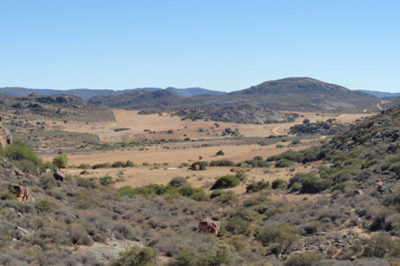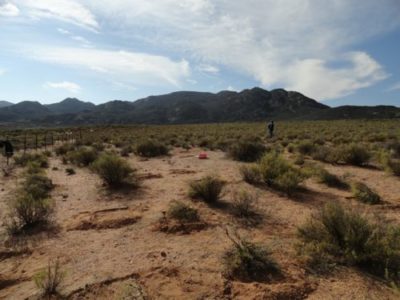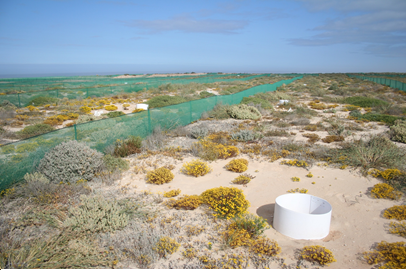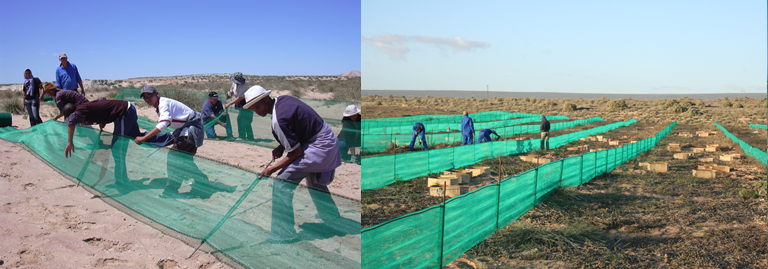Overview
Mining is one of the biggest threats for the long term sustainability of the unique and sensitive Namaqualand ecosystem. Namaqualand falls within the Succulent Karoo, one of only two semi-arid ecosystems to be included in the world’s 34 biodiversity hotspots – areas highlighted for conservation action because of the richness of their biodiversity, its uniqueness and the level of threat that it faces.
The Namaqualand Restoration Initiative (NRI) was founded by Dr. Peter Carrick (programme director & ecologist), of the Plant Conservation Unit of the University of Cape Town in 2005, with the aim of restoring areas damaged by mining. Previously, ad hoc restoration activities of mined-out areas have been ongoing by different mine operators and farmers across Namaqualand, but a co-ordinated, scientifically-based approach was lacking. The NRI emphasizes engagement with mine operators, capturing the expertise of restoration practitioners and use of scientifically based field experiments to develop novel restoration methods.
In addition to the start-up capital provided by the Critical Ecosystem Partnership Fund (CEPF)/Succulent Karoo Ecosystem Programme (SKEP), the NRI has received further funding from De Beers Namaqualand Mines. De Beers has also committed to financially support small businesses to do contract restoration work on their mined areas, and these teams will be trained according to the guidelines and methods developed by the NRI. These businesses will be run by restoration managers who will each manage a small team of people to do restoration.
Quick Facts
Project Location:
-31.1656799, 18.5930519
Geographic Region:
Africa
Country or Territory:
South Africa
Biome:
Desert/Arid Land
Ecosystem:
Other/Mixed
Area being restored:
<40,000 km2
Project Lead:
The Namaqualand Restoration Initiative
Organization Type:
University / Academic Institution
Location
Project Stage:
Planning / Design
Start Date:
2005-01-27
End Date:
2008-01-27
Primary Causes of Degradation
Mining & Resource ExtractionDegradation Description
Diamond mining or prospecting occurs in discontinuous patches along virtually all 400 kilometers of the Namaqualand coastline. Diamonds tend to lie in narrow seams up to 50 meters below the surface, and despite the relatively rich soil even in this arid habitat, open cast mining is the norm.
Historically, mines have been left open, with huge piles of “overburden” – the soil and sand that lie over the mineral deposits – on either side. Legislation passed in the last 15 years requires mining companies to restore the land to a state where it can support new land uses, which in Namaqualand is primarily livestock grazing.
Some operators have begun to implement basic rehabilitation efforts, but more often than not, this means merely shoving back what has been mined, irrespective of its complex original layering. In many areas, the layer of topsoil is as thin as 5 centimeters and even if it does get replaced correctly, it can quickly be eroded by the wind. Furthermore, most of the indigenous perennials so crucial for ecological recovery stand little chance of re-establishing themselves without assistance.
Reference Ecosystem Description
The rich biodiversity of the Succulent Karoo hotspot is due to an extensive and complex array of habitat types derived from topographical and climatic diversity in the region’s rugged mountains, semi-arid shrublands and coastal dunes. The hallmark of the hotspot is its exceptionally diverse and unique flora, especially succulents and bulbs. Many species are extreme habitat specialists, mainly related to soil type and of limited range size. Local endemism (i.e. the restriction of species to extremely small ranges of <50 km2) is most pronounced among bulbs and Mesembryanthemaceae and other succulents. Similar patterns of compositional change along gradients have been observed for certain groups of invertebrates. In addition to invertebrates, faunal diversity and endemism is high for reptiles, amphibians and some mammals.
Project Goals
The primary goals of NRI are to establish a restoration benchmark and develop new and effective regional protocols, based on sound ecological dynamics, to achieve near natural biodiversity restoration after mining operations. This should be done while giving a cross section of the regional community a greater role in restoration in the project region. Mining operators and other land users should be engaged to fundamentally change the way they perceive their roles and responsibilities with regard to biodiversity conservation and restoration.
Monitoring
The project does not have a monitoring plan.
Stakeholders
The NRI was created by Dr. Peter Carrick, an ecologist at the Plant Conservation Unit of the University of Cape Town, and is one of many projects in the CEPF/SKEP initiative. It has received funding from both CEPF/SKEP and the DeBeers Group, the world’s largest diamond mining company. The project intends to train and employ native Namaqualanders in the restoration of sites in the project region.
Description of Project Activities:
NRI team members interviewed farmers, mine operators, agricultural scientists, and restoration business owners to synthesize local, working knowledge of restoration techniques in the succulent karoo ecosystem. The knowledge gleaned from these interviews was used to develop guidelines and highlight gaps where more knowledge or scientific work was needed. One identified gap was the difficulty of establishing non-succulent perennial species on restored areas.
Another team then undertook field experiments to decipher the ecological requirements for establishing a diversity of perennial species on mined areas. They discovered that the first four to five months are the most critical for seedlings. Once seedlings have survived these first few months, they tend to make it through the dry summer season. NRI staff used the knowledge gained from these studies to begin testing "restoration packs" for mining companies to use in re-establishing indigenous plant communities that will, in turn, help stabilize ecosystems in the degraded areas. In addition to providing background information on the area, these packages contain seeds and equipment for planting. Seedlings are given all help possible--they are planted in boxes to provide extra protection from wind, and nutrients and water are added to give them an extra boost to help them establish good roots as fast as possible. 1,300 small plots were planted with 16 indigenous perennial species, and seedling survival is still being monitored. The treatment combination yielding the best results should be determined by the end of 2007.
NRI has also founded a new restoration business, NM Restoration, which is fully owned and run by three Namaqualanders. The NRI team held an intensive five day restoration training course in Namaqualand, which was attended by 47 candidates selected from 150 applicants. The trainees learned the techniques for successful restoration, including proper handling of topsoil, identification of local plant species to be used in restoration, methods of selecting, harvesting and storing viable seed, as well as methods of planting the seeds so as to achieve the greatest success, which includes protecting them from the wind of Namaqualand and ameliorating the soil altered by the mining process. Forty trainees successfully completed the course, 15 of whom have been employed by the newly established restoration business operating in its pilot year. More jobs will become available when NM Restoration expands its operations in the near future.
Ecological Outcomes Achieved
Eliminate existing threats to the ecosystem:
NRI's accomplishments so far have included two major strands:
1. By ecological experiment and observation, NRI staff have developed a thorough understanding of the underlying ecological dynamics and the constraints on plant establishment in Namaqualand systems.
2. A complete picture of current restoration techniques has been compiled through interviews with practitioners and from the literature.
This research has enabled NRI staff to develop novel techniques that facilitate the recruitment and establishment of perennial species in the succulent karoo. Based on this knowledge, a handbook and restoration pack for restoration practitioners in the mining and agricultural sectors has been produced.
Socio-Economic & Community Outcomes Achieved
Economic vitality and local livelihoods:
While the mining industry has provided many jobs for the people of Namaqualand in the past, these operations are slowly grinding to a halt. The joint opportunity to create employment and restore the environment has been seized by the economic and environmental role that NRI and NM Restoration will fulfill. As NRI trains teams of Namaqualanders in both ecological and business skills, mining companies will also be able to employ local people to implement restoration work. By doing this, companies hope to address the ongoing resentment among some local communities that they have not benefited from the region's extraordinary mineral wealth.
Key Lessons Learned
NRI Staff, students, and a number of research, business and conservation partners are involved in restoration research and implementation as a result of this project. The NRI has provided a bridge between restoration science and practice, and has provided economic benefits and offered a stake in restoration activities to those most affected by restoration efforts in Namaqualand.
Long-Term Management
Key objectives for the future include the continued training of local and regional experts who will act as restoration consultants for the mining and agricultural sectors. NRI plans to distribute its restoration handbook freely amongst land-users in Namaqualand.
Another component of this programme is the commitment by the University of Cape Town’s Plant Conservation Unit (PCU) to Renu-Karro Veld Restoration cc. This initiative, established in 2007, is based in Prince Albert and aims to use local plants to restore degraded lands, thereby sustaining local services and generating sustainable livelihoods. The PCU will engage with Renu-Karoo through limited financial support and restoration research once projects become available and student interest develops.
Sources and Amounts of Funding
>450,000 USD Start-up funding in the amount of $200,000 was provided by a CEPF grant, and further funding of over $250,000 was provided by the De Beers Group.
Other Resources
Peter Carrick
NRI Project Director
Plant Conservation Unit of the University of Cape Town
E-mail: [email protected]
Publications:
Peer Reviewed:
P.J. Carrick. Competitive and facilitative relationships among three shrubs in the Succulent Karoo, South Africa, and the role of browsing intensity and rooting depth. Paper in press. Journal of Vegetation Science.
P.J Carrick. Different land-use options produce a gradient of plant richness at a single location in Namaqualand: the pattern and the processes. Paper in press. Proceedings of the 7 th International Rangelands Congress, Durban, South Africa. (Abstract in: African Journal of Range & Forage Science 20)
Not Peer Reviewed:
http://www.pcu.uct.ac.za/research.html
http://www.skep.org/projects.php?intProjectId=17
http://www.celb.org/xp/CELB/news-events/features/debeers.xml
http://www.cepf.net/xp/cepf/news/in_focus/2007/sept0407_feature.xml
http://www.debeersgroup.com/debeersweb/Investing+in+the+Future/Environment/Case+study+-+Succulent+Karoo+Ecosystem+Programme+(SKEP).htm





